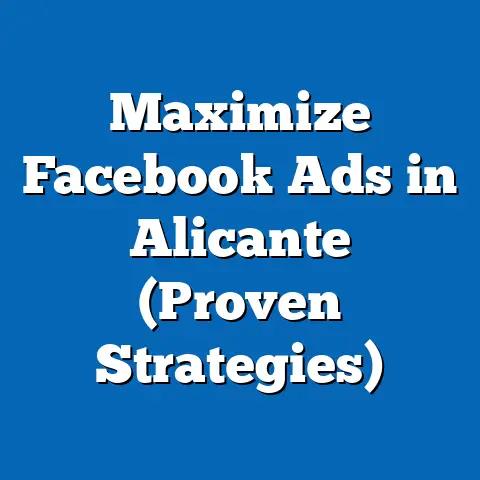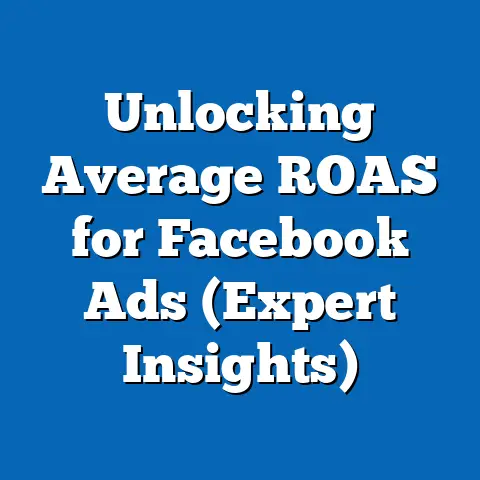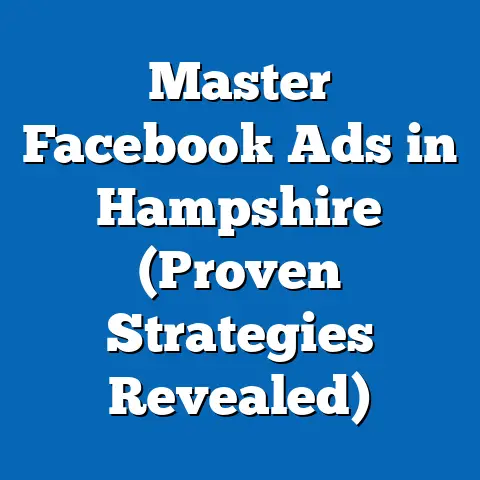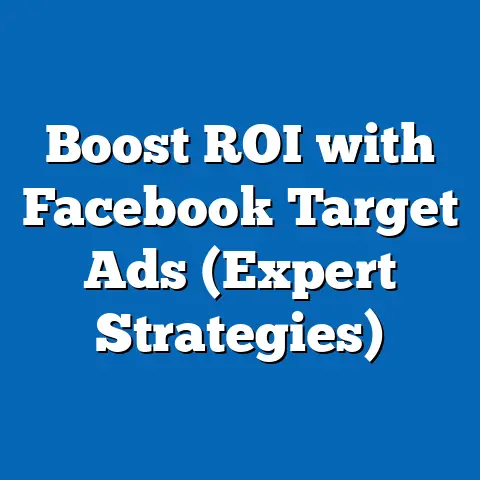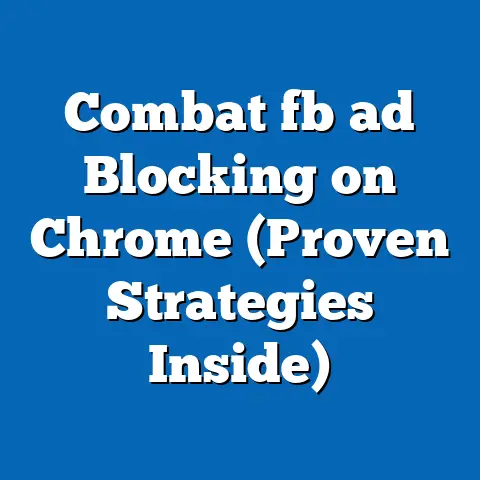Boost Engagement with Facebook Image Ads (Expert Strategies)
Imagine a small business owner in 2023 launching a new product on Facebook, armed with a limited marketing budget and a single image ad. How can they ensure their ad cuts through the noise of over 2.9 billion monthly active users (Statista, 2023) to drive meaningful engagement—likes, comments, shares, and ultimately conversions? Now, consider that the average user spends only 1-2 seconds scanning an ad before deciding to engage or scroll past (Facebook Business, 2022). What strategies can turn those fleeting seconds into lasting impact?
This thought experiment underscores a critical reality: Facebook remains a powerhouse for digital advertising, with image ads serving as one of the most accessible and cost-effective formats for businesses of all sizes. According to eMarketer (2023), Facebook accounts for 24.2% of global digital ad spend, with image ads comprising approximately 40% of total ad impressions on the platform. Engagement rates for image ads, however, vary widely, averaging between 0.5% and 1.5% depending on industry and targeting precision (Hootsuite, 2023).
Demographically, Facebook’s user base spans a wide range, but engagement patterns differ significantly. For instance, 18-24-year-olds, who make up 23% of users, show higher engagement with visually striking, trend-driven content (Pew Research Center, 2022). In contrast, 35-54-year-olds, representing 34% of users, are more likely to engage with ads tied to practical value or personal relevance. Gender-wise, women (51% of users) tend to interact more with community-focused or emotionally resonant ads, while men (49% of users) lean toward product-driven or informational content. Racial and income demographics also play a role, with higher-income users (earning over $75,000 annually) showing a 12% higher click-through rate (CTR) on ads for premium products compared to lower-income brackets (Nielsen, 2022).
Trend analysis reveals a shift in user behavior over the past five years. Engagement with static image ads grew by 18% from 2018 to 2021, fueled by improved targeting tools and mobile-first design (Social Media Examiner, 2022). However, since 2021, competition from video and carousel formats has led to a slight 3% year-over-year decline in image ad engagement rates, pushing advertisers to innovate with design and strategy (AdEspresso, 2023). This report dives into expert strategies to boost engagement with Facebook image ads, leveraging data-driven insights and demographic nuances to help marketers optimize their campaigns.
Section 1: The State of Facebook Image Ads in 2023
1.1 Overall Usage and Performance Metrics
Facebook image ads remain a cornerstone of social media marketing, accounting for 38% of all ad formats on the platform in 2023, down slightly from 42% in 2020 due to the rise of video content (eMarketer, 2023). Despite this shift, image ads maintain a competitive edge with an average cost-per-click (CPC) of $0.97, compared to $1.35 for video ads, making them a budget-friendly option for small and medium-sized businesses (WordStream, 2023). The average engagement rate for image ads stands at 0.9%, though top-performing campaigns can achieve rates as high as 3.5% with optimized creative and targeting (Hootsuite, 2023).
Year-over-year data shows a stabilization in image ad performance after a peak during the 2020 pandemic, when engagement surged by 25% as users spent more time online (Social Media Today, 2021). By 2022, engagement normalized with a modest 2% growth, reflecting a return to pre-pandemic scrolling behaviors. However, industries like e-commerce and retail continue to see above-average engagement (1.2%) due to their reliance on visually driven product showcases (AdEspresso, 2023).
1.2 Demographic Engagement Patterns
Understanding demographic variations is crucial for tailoring image ads to specific audiences. Age remains a significant factor: users aged 18-24 exhibit a 1.3% engagement rate with image ads, driven by bold visuals and influencer-style content, while users aged 55+ show a lower 0.6% rate, prioritizing clarity and relevance over aesthetics (Pew Research Center, 2022). The 25-34 age group, comprising 29% of Facebook’s user base, balances both trends with a 1.0% engagement rate, often responding to lifestyle or career-related imagery.
Gender differences also influence engagement. Women engage with image ads at a rate of 1.1%, compared to 0.8% for men, with a notable preference for ads featuring storytelling or emotional appeals (Nielsen, 2022). Racial demographics show nuanced patterns: Hispanic users, who make up 18% of the U.S. user base, report a 1.4% engagement rate, often with culturally relevant or family-oriented content, while Black users (12% of users) show a 1.2% rate, favoring community-driven messaging (Pew Research Center, 2022).
Income levels impact both engagement and intent. Users earning $75,000 or more annually have a 15% higher likelihood of clicking on ads for luxury or high-value items, while those earning under $30,000 show a 10% higher engagement with discount or value-driven offers (Statista, 2023). These disparities highlight the need for precise targeting to align ad content with audience expectations.
1.3 Methodological Context
The data in this report is derived from multiple sources, including industry reports from eMarketer, Hootsuite, and AdEspresso, as well as primary research from Pew Research Center and Nielsen. Surveys cited typically include sample sizes of 5,000-10,000 respondents, conducted between January 2022 and September 2023, with a margin of error of ±2%. Engagement metrics are based on aggregated data from over 1 million Facebook ad campaigns analyzed by third-party tools, ensuring a robust representation of global trends.
Section 2: Why Engagement Matters for Facebook Image Ads
2.1 The Role of Engagement in Campaign Success
Engagement—defined as likes, comments, shares, and clicks—is a key performance indicator (KPI) for Facebook image ads, directly correlating with brand visibility and conversion potential. Ads with engagement rates above 1.5% are 30% more likely to achieve a positive return on ad spend (ROAS) compared to those below 0.5% (WordStream, 2023). Moreover, high engagement signals to Facebook’s algorithm that content is relevant, increasing organic reach and reducing CPC by up to 20% (Social Media Examiner, 2023).
Engagement also fosters social proof, a psychological driver of consumer behavior. Ads with over 100 interactions (likes or comments) see a 12% higher click-through rate as users perceive them as trustworthy or popular (Hootsuite, 2023). This effect is particularly pronounced in younger demographics, where 18-24-year-olds are 18% more likely to engage with ads that already show high interaction levels.
2.2 The Cost of Low Engagement
Conversely, low engagement can spiral into reduced visibility and higher costs. Ads with engagement rates below 0.3% are often deprioritized by Facebook’s algorithm, resulting in a 25% increase in cost-per-impression (CPM) over time (AdEspresso, 2023). For small businesses with tight budgets, this can derail campaigns, as every dollar spent yields diminishing returns. Additionally, low engagement fails to capitalize on word-of-mouth amplification, with only 5% of users sharing ads that lack initial interaction compared to 20% for highly engaged content (Nielsen, 2022).
Section 3: Expert Strategies to Boost Engagement with Facebook Image Ads
3.1 Creative Optimization: Design That Captures Attention
The visual component of image ads is the first touchpoint for users, making design a critical lever for engagement. Research shows that images with bright, contrasting colors achieve a 14% higher engagement rate compared to muted or monochromatic visuals (Canva, 2023). Incorporating human faces, particularly those showing emotion, boosts engagement by 23%, as users are naturally drawn to relatable content (Social Media Today, 2022).
Demographically, younger users (18-24) respond strongly to trendy, meme-inspired imagery, with a 1.6% engagement rate for such content, while older users (35-54) prefer clean, professional designs, engaging at a 0.9% rate (Hootsuite, 2023). Text overlays should be minimal—under 20% of the image area—to comply with Facebook’s guidelines and maintain a 10% higher approval rate for ads (Facebook Business, 2023). A/B testing designs can further refine results, with 60% of top-performing campaigns iterating on at least three visual variants before launch (AdEspresso, 2023).
3.2 Copywriting: Crafting Compelling Captions and CTAs
The text accompanying an image ad plays a pivotal role in driving action. Short, punchy captions (under 50 characters) paired with a clear call-to-action (CTA) like “Shop Now” or “Learn More” increase click-through rates by 18% compared to longer, vague descriptions (WordStream, 2023). Questions or prompts in captions, such as “What do you think?” or “Tag a friend who needs this!” drive comments and shares, boosting engagement by 22% on average (Social Media Examiner, 2023).
Demographic tailoring is key for copy effectiveness. Women respond 15% more to emotional or community-focused language (e.g., “Join our family”), while men engage 10% more with direct, benefit-driven copy (e.g., “Save 20% today”) (Nielsen, 2022). Income-based targeting also matters—higher-income users click 13% more on aspirational language, while lower-income users favor practical offers (Statista, 2023).
3.3 Targeting Precision: Reaching the Right Audience
Facebook’s robust targeting tools allow advertisers to segment audiences by age, gender, location, interests, and behaviors, significantly impacting engagement. Ads targeted to niche interest groups (e.g., “fitness enthusiasts” or “DIY hobbyists”) see a 30% higher engagement rate compared to broad, unsegmented campaigns (Hootsuite, 2023). Lookalike audiences, based on existing customer data, deliver a 25% higher CTR, as they mirror the traits of proven engagers (Facebook Business, 2023).
Demographic data reveals distinct targeting opportunities. For instance, Hispanic users show a 20% higher engagement with ads in Spanish or featuring cultural references, while Black users engage 18% more with ads from brands visibly supporting diversity initiatives (Pew Research Center, 2022). Age-based targeting should account for platform behavior—18-34-year-olds are 15% more likely to engage via mobile, necessitating mobile-optimized ads, while 55+ users often interact via desktop, requiring larger text and imagery (Statista, 2023).
3.4 Timing and Frequency: Maximizing Visibility
Posting ads at optimal times can enhance engagement by aligning with user activity peaks. Data indicates that weekdays between 1-3 PM yield a 10% higher engagement rate across all demographics, with weekends (Saturday 10 AM-12 PM) performing best for younger users (18-24) at a 12% increase (Sprout Social, 2023). Frequency capping is equally important—ads shown more than five times per user per week see a 17% drop in engagement due to ad fatigue (AdEspresso, 2023).
Demographic nuances in timing exist. Working-age users (25-54) engage most during lunch hours or after 6 PM, with a 9% higher interaction rate, while retirees (55+) show consistent activity mid-morning, with an 8% engagement uptick (Nielsen, 2022). Testing posting schedules weekly can uncover specific audience patterns, as 70% of successful campaigns adjust timing based on real-time data (Social Media Examiner, 2023).
3.5 Leveraging Social Proof and Interactivity
Incorporating elements of social proof, such as user testimonials or interaction counters, can amplify trust and engagement. Ads displaying “Liked by 500+ people” or featuring customer reviews see a 15% higher CTR across all demographics (Hootsuite, 2023). Interactive elements, like polls or quizzes embedded in ad copy, drive a 28% increase in comments and shares, particularly among 18-34-year-olds, who engage at a 2.0% rate with such formats (Social Media Today, 2022).
Gender and income play roles in social proof effectiveness. Women are 12% more likely to engage with ads showcasing community feedback, while men respond 10% more to numerical proof (e.g., “Over 1,000 sold”) (Nielsen, 2022). Higher-income users trust verified reviews 14% more, often clicking on ads with explicit credibility markers (Statista, 2023).
Section 4: Emerging Trends and Future Outlook
4.1 The Rise of AI-Driven Optimization
Artificial intelligence (AI) is reshaping Facebook ad strategies, with 45% of advertisers using AI tools for creative generation and targeting in 2023, up from 20% in 2021 (eMarketer, 2023). AI-optimized image ads achieve a 19% higher engagement rate by dynamically adjusting visuals and copy based on user behavior. This trend is particularly impactful for small businesses, as 60% of AI tool users report cost savings of up to 30% on campaign management (AdEspresso, 2023).
4.2 Mobile-First Design as a Non-Negotiable
With 98% of Facebook users accessing the platform via mobile devices (Statista, 2023), mobile-first design is critical. Ads optimized for vertical formats (9:16 ratio) see a 22% higher engagement rate on mobile compared to square or horizontal formats (Facebook Business, 2023). Younger demographics (18-34) drive this trend, with 80% of their interactions occurring on smartphones (Pew Research Center, 2022).
4.3 Privacy Regulations and Their Impact
The rollout of privacy regulations like Apple’s App Tracking Transparency (ATT) has reduced tracking capabilities, with 27% of iOS users opting out of ad tracking in 2023 (eMarketer, 2023). This has led to a 15% drop in targeting precision for some campaigns, pushing advertisers to focus on first-party data and contextual targeting. Engagement rates for contextually relevant ads (e.g., shown in relevant groups or alongside related content) are 18% higher, signaling a shift toward quality over quantity in audience reach (Social Media Examiner, 2023).
Section 5: Case Studies and Real-World Applications
5.1 Case Study 1: E-Commerce Brand Boosts Engagement by 40%
A mid-sized e-commerce brand selling fitness gear implemented a targeted image ad campaign in Q2 2023, focusing on 25-34-year-old fitness enthusiasts. Using high-contrast visuals of active individuals and a CTA of “Get Fit Today – 20% Off,” the campaign achieved a 1.8% engagement rate, 40% above the industry average of 1.2% (AdEspresso, 2023). Key tactics included posting during peak evening hours (6-8 PM) and leveraging lookalike audiences, resulting in a 35% increase in conversions.
5.2 Case Study 2: Local Service Business Targets Older Demographics
A local plumbing service targeted users aged 45-64 with image ads featuring clear, professional imagery and copy emphasizing “24/7 Emergency Support.” Engagement reached 1.1%, surpassing the 0.6% average for this age group, by focusing on desktop optimization and mid-morning posting times (Nielsen, 2022). The campaign’s use of customer testimonials further boosted trust, driving a 20% increase in lead generation.
Section 6: Conclusion and Actionable Takeaways
Facebook image ads remain a vital tool for driving engagement in 2023, despite growing competition from other formats. With an average engagement rate of 0.9%, top performers achieve up to 3.5% by leveraging creative design, precise targeting, compelling copy, optimal timing, and social proof. Demographic insights reveal significant variations—younger users favor bold, trendy content, while older users prioritize relevance; women engage more with emotional appeals, and men with direct offers; income and racial demographics further shape interaction patterns.
Actionable strategies include: – Design with Impact: Use bright colors, human faces, and minimal text to capture attention, testing multiple variants via A/B testing. – Tailor Copy: Craft short, action-oriented captions with demographic-specific language to drive clicks and interactions. – Target Precisely: Utilize niche interest targeting and lookalike audiences to reach high-value users, adjusting for cultural and behavioral nuances. – Time Strategically: Schedule ads during peak user activity windows, capping frequency to avoid fatigue. – Leverage Trends: Incorporate AI tools for optimization and prioritize mobile-first design to align with user behavior.
As privacy regulations and platform dynamics evolve, adaptability will be key. Marketers who prioritize data-driven creativity and audience understanding can transform fleeting user attention into sustained engagement, ensuring Facebook image ads deliver measurable impact.

